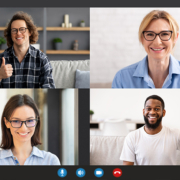Let’s face it. COVID-19 has created a profound change in the way we meet and exchange ideas. Event organizers and managers are now faced with a sink-or-swim challenge – creating imaginative new ways to hold events or bust.
Out of necessity, but accustomed to always having a ‘Plan B,’ event organizers quickly pivot to a whole new world of challenges. Now the hybrid event, a combination of in-person and virtual experiences, is becoming the hottest trend in planning and holding events.
Organizing registrations, boosting virtual engagement, and networking for the hybrid option now propels your responsibilities to new heights. No less daunting is the task of ensuring that the technical aspects of hybrid events roll out without a hitch. Requirements for the audio, visual, and lighting aspects of a hybrid event have become doubly important.
Here are some tips to help you take on these technical challenges while considering attendees’ two different experiences during a hybrid event.
Choose A Venue That Can Support Technical Needs
For the in-person piece of your hybrid event, you have many new boxes to check when choosing a venue. Everything from a schedule to sanitize surfaces, to room airflow and physical distancing is now on your list. Audio, visual, and lighting capabilities should also be on your list when narrowing down the venue choices. But more on that below. First, let’s look at the factors affecting the streaming of your event.
High-Speed Internet + Loads of Bandwidth is A Must!
Maybe you’re planning a large-scale hybrid event that includes online learning applications, streaming audio/video, and the ability to download brochures or other digital materials. You’re going to need the highest speed internet and bandwidth possible. This is true, not only for online participants. In-person attendees also need uninterrupted access to their email and any streaming or virtual elements needed to connect with the remote participants.
Imagine a couple hundred people using mobile devices and laptops simultaneously to participate in online polls, attend virtual lounges, and consume streaming audio/video. That’s going to take a lot of bandwidth! The more attendees you have, the higher the demand.
Inadequate speed and bandwidth can ruin your audio and video with remote participants experiencing lag time, or even worse – seeing a frozen screen and leaving the event thinking they’ve lost their own connection.
Ask the venue for their upload/download speeds. If your venue can’t support the demand or the cost is prohibitive, investigate purchasing an internet package from an ISP that provides wireless service for major events. You might even arrange for your own private network, which means you won’t have to worry about outsiders in the same venue gobbling up bandwidth.
Audio
What is the most common phrase you’ve heard online over the past year?
“You’re on mute.”
“We can’t hear you.”
“Sorry, we’re having technical difficulties.”
Audio problems are one of the most common reasons people get frustrated in a virtual setting and leave, so you must get this aspect of your event right.
For crystal clear audio, include a quality microphone on the checklist for remote presenters. Ask them to ensure that they have a quiet room with no pets or children demanding attention. A good P.A. system is a must at the live venue, and presenters who move around will need lavalier microphones.
As for your web-based system, make sure you’re using an advanced online platform that includes reliable audio technology. For example, consider a Webinar Event Management platform that provides high-end customer support.
To avoid lag when remote participants interact with live presenters, ensure your audio streaming does not automatically include a delay.
Visuals
You’ve become a master of curating content at your events, packing them with fascinating guests, images, slides, and videos. At a hybrid event, you need to boost the engagement of virtual attendees who need extra attention to detail. For example, try adjusting your camera angles to show the presenters’ faces and expressions more clearly for remote viewers.
If you plan to show a remote guest on screen interacting with an in-person presenter, position a screen at the presenter’s side. When not used for conversation, this screen can be turned on to display remote attendees, connecting the two audiences. The live presenter can then turn to the remote guest and interact in a traditional in-person conversation.
For video and slide presentations, do tests to check if all visual elements can be easily seen when viewed on a laptop. You’ll need a high-resolution video feed to ensure your content is clear and legible, especially if the text appears on slides. Recorded videos should be shot with high-definition cameras for a crisp look, and screens should be big enough for both in-person and remote attendees to see the content.
Lighting
At a hybrid event, you need to heighten the immersive experience for your virtual attendees. Good lighting is crucial to ensure remote viewers feel like they really are a part of it all. Your expensive cameras and screens will be wasted without proper lighting.
One way to help remote viewers have the best experience is to include shots of the live audience during the action to ensure that lighting covers both the stage and the audience. In addition, lighting may need to cover specific audience locations, for example, where mics are set up for Q&A sessions.
Ask remote presenters to ensure a clean background with no distractions behind them and request they purchase a video conference lighting kit. These affordable video kits can include a stand, a phone holder, and an LED ring light that clips onto their laptop to soft light their face.
When looking for the best lighting options at the venue, consider brightness, adjustability, and durability. It would be best to choose durable LED floodlights for longer distances or a softer ring light for closeups of the talent.
Enlist Support
Even if you’ve thought of everything, minor and sometimes major mishaps can happen during any event.
If you want extra insurance for a smooth program, ensure technical support is dedicated to troubleshooting at the event. Internet connections, network, visual, audio, and lighting need constant vigilance to prevent and fix any issues.
Hold a rehearsal with support and include a team of testers viewing remotely on laptops to report any concerns. Keep a list of mobile phone numbers for each of your support contacts to quickly troubleshoot any problem that may arise.
The big day is coming! With eShow’s web-based products and services, rest assured you’ll have customer support helping you master the technical challenges of your hybrid event.







